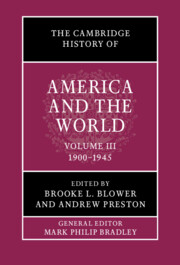Book contents
- The Cambridge History of America and the World
- The Cambridge History of America and the World
- The Cambridge History of America and the World
- Copyright page
- Contents
- Figures
- Maps
- Contributors to Volume III
- General Introduction: What is America and the World?
- Introduction to Volume III
- Part I American Power in the Modern Era
- 1 The Sinews of Globalization
- 2 The Territorial Empire
- 3 Waging World War I
- 4 Technological Transformations
- 5 Law and American Power
- 6 Latin America and US Global Governance
- 7 Transatlantic Relations
- 8 The Open Door, Tsarist Russia, and the Soviet Union
- 9 The Rise of the Modern Middle East
- 10 Competing Empires in Asia
- 11 Making a Modern Military
- Part II Competing Perspectives
- Part III The Perils of Interdependence
- Index
2 - The Territorial Empire
from Part I - American Power in the Modern Era
Published online by Cambridge University Press: 12 November 2021
- The Cambridge History of America and the World
- The Cambridge History of America and the World
- The Cambridge History of America and the World
- Copyright page
- Contents
- Figures
- Maps
- Contributors to Volume III
- General Introduction: What is America and the World?
- Introduction to Volume III
- Part I American Power in the Modern Era
- 1 The Sinews of Globalization
- 2 The Territorial Empire
- 3 Waging World War I
- 4 Technological Transformations
- 5 Law and American Power
- 6 Latin America and US Global Governance
- 7 Transatlantic Relations
- 8 The Open Door, Tsarist Russia, and the Soviet Union
- 9 The Rise of the Modern Middle East
- 10 Competing Empires in Asia
- 11 Making a Modern Military
- Part II Competing Perspectives
- Part III The Perils of Interdependence
- Index
Summary
“America has never been an empire,” pronounced George W. Bush in his first foreign policy address. “We may be the only great power that had the chance, and refused – preferring greatness to power and justice to glory.”1
As presidential sentiments go, this was a cliché. Nearly every president in the twentieth century offered some platitude about how the United States does not covet territory. And yet the United States has had an empire, in the sense of possessing overseas territories, stretching from the Arctic to the South China Sea to the Caribbean. They ranged from the large landmass of Alaska to the small island of Guam, from populous territories (the Philippines) to sparse ones (American Samoa). They have been called many things: protectorates, possessions, territories, outlying areas. But at the turn of the twentieth century, when the bulk of them were acquired, there was little doubt what they were. As the leaders of the country put it plainly, they were colonies.
- Type
- Chapter
- Information
- The Cambridge History of America and the World , pp. 62 - 84Publisher: Cambridge University PressPrint publication year: 2022

